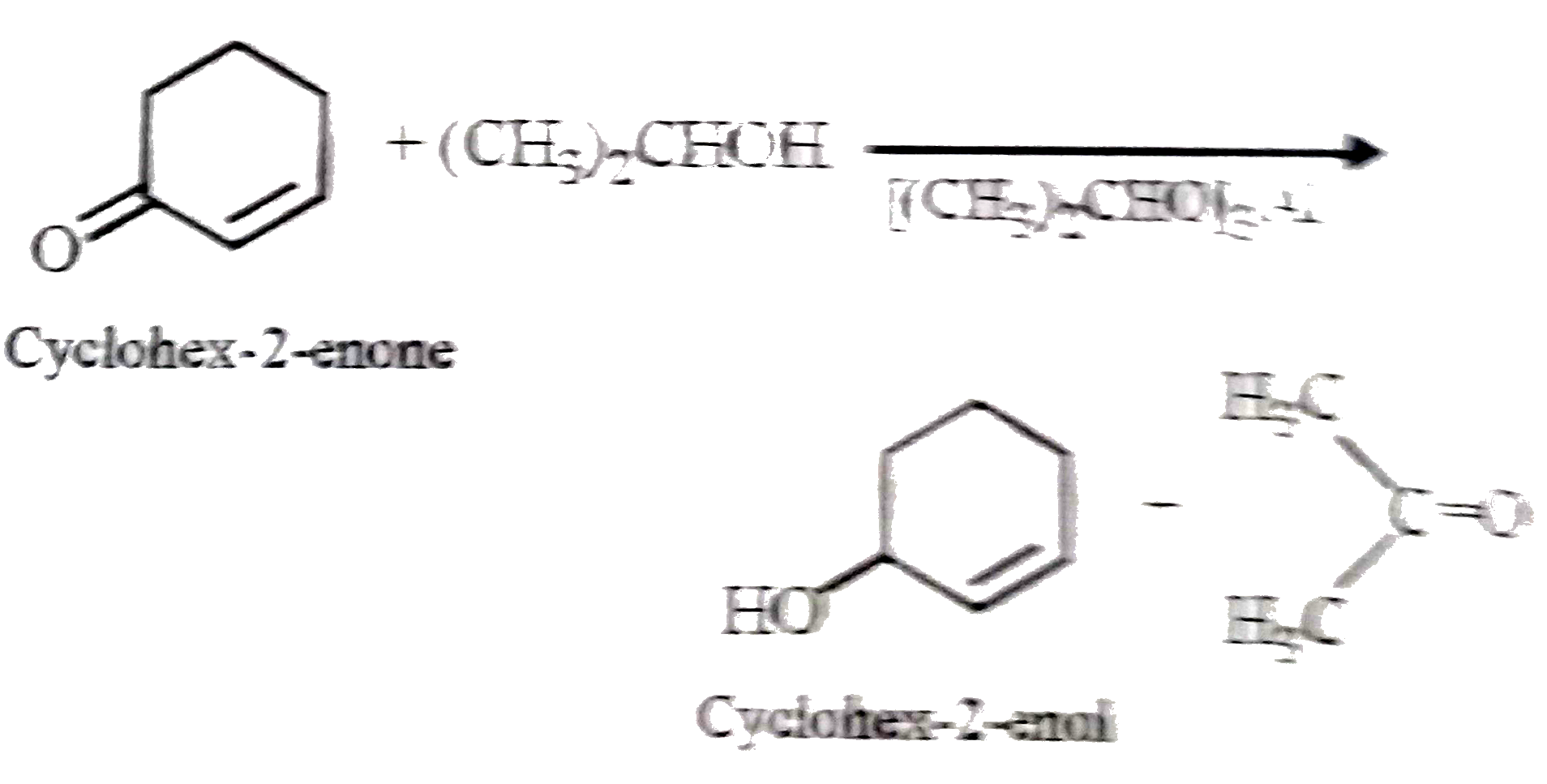Reduction with aluminium isopropoxide in excess of Isopropyl alcohol is called Meerwein Ponndorff-Verley reduction (MPV). What will be the final product when cyclohex-2-enone is selectively reduced in MPV reaction ?
Cyclohexanol
Cyclohex-2-enol
Cyclohexanone
Benzene.
The correct Answer is:A

Here only >C=O group is reduced to >CHOH group. However group like CH2=CH2 does not get reduced.
Similar Questions
Knowledge Check
- Question 1 - Select One
Reduction of cyclohex-2-enone with aluminium isopropoxide in excess of isopropyl alcohol with produce
ACyclohexanolBCyclohex-2-enolCCyclohexanoneDBenzene - Question 2 - Select One
Nitrous acid reacts with all classes of amines. The product obtained from these reactions depend on whether primary, secondary or tetriary and ,wheather the amine or aliphatic or aromatic.
Aliphalic primary amines react with acid (NaNO2+HCl) to form alcohol as major product. In , addition to alcohol, alkene and alkyl halides are also formed as minor product.
Certain cyclic primary amines can undergo either ring expansion or ring contraction reactions on treatment with acid. This reaction is called Demajanov ring expansion or contraction.

What will be the major product when 2-aminopropane is treated with nitrous acid?A1-propanolB2-propanolCPropeneDCyclopropane - Question 3 - Select One
2-Bromopentane is treated with alcoholic KOH solution. Whatt will be the major product formed in this reaction and what is the type of elimination called?
APent-1-ene, β-EliminationBPent-2-ene, β-eliminationCPent-1-ene, Nucleophilic substitutionDPent-2-ene, Nucleophilic substitution.
Oxidation and reduction process involves the transaction of electrons. Loss of electrons is oxidation and the gain of electrons is reduction. It is thus obvious that in a redox reaction, the oxidant is reduced by accepting the electrons and the reductant is oxidised by losing electrons. The reactions in which a species disproportionates into two oxidation states (lower and higher) are called disproportionation reactions. In electrochemical cells, redox reaction is involved, i.e., oxidation takes place at anode and reduction at cathode.
Select the correct statement:View SolutionOxidation and reduction process involves the transaction of electrons. Loss of electrons is oxidation and the gain of electrons is reduction. It is thus obvious that in a redox reaction, the oxidant is reduced by accepting the electrons and the reductant is oxidised by losing electrons. The reactions in which a species disproportionates into two oxidation states (lower and higher) are called disproportionation reactions. In electrochemical cells, redox reaction is involved, i.e., oxidation takes place at anode and reduction at cathode.
The reaction Cl2→Cl−+ClO−3 is:View SolutionOxidation and reduction process involves the transaction of electrons. Loss of electrons is oxidation and the gain of electrons is reduction. It is thus obvious that in a redox reaction, the oxidant is reduced by accepting the electrons and the reductant is oxidised by losing electrons. The reactions in which a species disproportionates into two oxidation states (lower and higher) are called disproportionation reactions. In electrochemical cells, redox reaction is involved, i.e., oxidation takes place at anode and reduction at cathode.
Detennine the change in oxidation number of sulphur in H2SandSO2 respectively in the following reaction:
2H2S+SO2→2H2O+3SView SolutionOxidation and reduction process involves the transaction of electrons. Loss of electrons is oxidation and the gain of electrons is reduction. It is thus obvious that in a redox reaction, the oxidant is reduced by accepting the electrons and the reductant is oxidised by losing electrons. The reactions in which a species disproportionates into two oxidation states (lower and higher) are called disproportionation reactions. In electrochemical cells, redox reaction is involved, i.e., oxidation takes place at anode and reduction at cathode.
In the reaction:
I2+2S2O2−3→2I−+S4O2−6View SolutionNitrous acid reacts with all classes of amines. The product obtained from these reactions depend on whether primary, secondary or tetriary and ,wheather the amine or aliphatic or aromatic.
Aliphalic primary amines react with acid (NaNO2+HCl) to form alcohol as major product. In , addition to alcohol, alkene and alkyl halides are also formed as minor product.
Certain cyclic primary amines can undergo either ring expansion or ring contraction reactions on treatment with acid. This reaction is called Demajanov ring expansion or contraction.

Which of the following product(s) will be obtained when isopropylamine is treated with sodium nitrite and hydrochloric acid?View Solution

